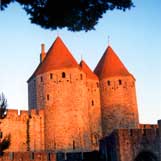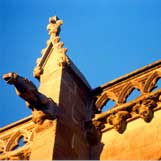French History 101


French History 101
We believe that when you travel to Europe you should have a basic knowledge of the history of the country or area you are visiting. Here is our brief history of France refresher course.
Early Beginnings
-
Evidence of prehistoric man is found in caves in the Dordogne Region. In the caves are paintings dating back to 12000 BC. Several caves can be toured, most popular are those at Lascaux.
-
Some 10,000 stone megaliths dating back to 2800 BC are found in France. The majority of these Stonehenge type tombs ( Dolmens) are found in Brittany, near Carnac.
-
From 1500 BC to 500 BC the Celts (from northern Europe) came south to establish trade with Greeks (from Southern Europe). This Celtic influence is still felt throughout northeastern France. One Celtic tribe named Parii inhabited an island in the Seine River. This island is now called Ile de la Cité, in the heart of Paris.
Roman Empire
-
By 145 BC the Roman Empire was dominating much of Europe including what is now southern France.
-
By 29 BC the Roman Empire had cities throughout most of France, leaving behind the best Roman ruins outside Italy. The very best of these are found in the Provence region.
-
Roman rule was overthrown about 500 AD by several smaller united tribes called the Franks.
500-1500 AD
-
The Franks continued to rule from the 5th to10th century. During this period France was made up of several small feudal states.
-
A very popular emperor during this time was Charlemagne, crowned in 800 AD.
-
The Vikings invade northern France in the 900s, making their Duchy in Normandy.
-
In 1066 William the Conqueror of Normandy invades England. This event turns parts of England over to French rule. This story is recounted on the famous Bayeux tapestry.
-
In 1152, Eleanor of Aquitane marries Henry II of England. This wedding transfers about 1/3 of France to English power.
-
A struggle to regain land from England continued from the 12th to the 14th century. The climax was the Hundred Years’ War (1337 to 1453).
-
In 1429 a young woman named Joan of Arc persuaded the French King to continuing fighting the English. This took place in Orléans, where today you can visit sites about her life.
-
During this period the Crusades (religious wars) also took place and the Gothic Cathedrals that are found throughout France were built.
Renaissance, Kings & the Revolution
-
The 16th century brought a shift from an Empire to Monarchy.
-
The Renaissance was happening in Italy! This period was a re-birth of culture and advancement in art, architecture and music.
-
The French Kings brought artists from Italy to help design and decorate their royal palaces and châteaux in Paris and the Loire Valley. One of the most famous was Leonardo da Vinci, whose home can be toured in Amboise.
-
Louis XIV ruled from 1643-1715. He had more money than you can imagine at a time when most citizens are poor. He built the palace at Versailles.
-
Louis XV ruled from1715-1774, and during his reign ideas of opposing the monarchy began to surface.
-
Louis XVI and his wife Marie-Antoinette came to power in 1774. They were unable to handle the country’s economic troubles and the poor became very restless.
-
The end of the monarchy was started by the storming of the Bastille in Paris on July 14th, 1789. The French Revolution began and shortly thereafter the royals lost their heads to the guillotine. July 14th remains a National Holiday.
-
A period known as the “Reign of Terror” was to follow. Over 17,000 people lost their heads and religious freedoms were revoked.
Napoleon
-
Not happy with the status quo, Napoleon Bonaparte, a general from Corsica, put himself in power in 1799 and he was crowned emperor in 1803.
-
He expanded his empire with wars across Europe until his defeat at Waterloo in 1815.
-
He had grand ideas of large boulevards (Champs Elysées) for military marches and arches (Arc de Triomphe) to enter the city of Paris. Most of these ideas did not become reality until after his death.
World Wars I and II
-
Nearly half of all French men were killed or maimed near Verdun during WW I, which was waged partly over the regions of Alsace and Lorraine. Today you can visit the battlefields, cemeteries, and the place where the Germans surrendered. The war ended with the Treaty of Versailles (1919).
-
20 years later France was occupied by Germany from 1940 to 1944 during WW II. The occupation ended in 1944 with invasion of the Allies in Normandy on June 6th.
The EEC and the EU
-
After World War II and some major rebuilding, France was strong enough to be a founding member of the European Economic Community (EEC) in 1957.
-
In 1958 Charles de Gaulle started the current form of government, including an elected President, Senate and an appointed Council.
-
In 1993 the EEC became the European Union (EU) with it's headquarters in Strasbourg, France.

Europe travel news sent to you 15 times a year.
Top sights, hotel reviews, travel tips and more.
Private Tours in France, Greece, Italy and Spain.
Join one of our small group Europe tours.
Tours and day trips to help you explore Europe.
Hire a professional from Private Guides in Europe.
Let us help personalize your European itinerary.
Our thoughts on how to best travel in Europe.
For more information or to send us an email.
Car Rentals, Flights, Hotels, Rail Passes
